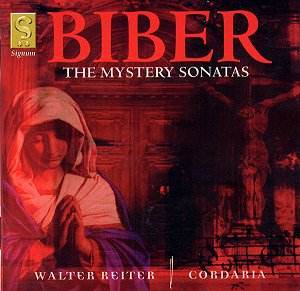|
|
Search MusicWeb Here |
|
 |
||
|
Founder:
Len Mullenger (1942-2025) Editor
in Chief:John Quinn
|
|
|
Search MusicWeb Here |
|
 |
||
|
Founder:
Len Mullenger (1942-2025) Editor
in Chief:John Quinn
|
 |
Heinrich Ignaz BIBER (1644-1704)
Make a HUGE saving by downloading this disc |
| CD available for post-free online mail-order or you may download individual tracks. For some labels you can download the entire CD with a single click and make HUGE savings. The price you see is the price you pay! The full booklet notes are available on-line. | |
|
NOTE • Click on the button and you can buy the disc or read the booklet details • You can also access each track which you may then sample or down load. • Further Information. |
|
|
The ‘Mystery Sonatas’ consist of 15 short suites for violin and continuo whose inspiration lies in the so-called 15 mysteries of the Virgin Mary; effectively 15 meditations which are sometimes directly programmatic and sometimes more elusive. They divide into three groups of five. The Joyful Mysteries are based on episodes in Jesus’s early life, the Nativity for example; the middle group are the Sorrowful Mysteries like ‘The Crown of Thorns’ etc; and the final group are the Glorious Mysteries which continue the story from the Resurrection to the Assumption and then to the Coronation of the Virgin. The whole work is capped off by a grand unaccompanied Passacaglia for Violin. The whole sequence lasts about two hours and a quarter and is therefore on two discs. Sadly the middle group of five has had to be divided, with the last one, the Crucifixion, on the second disc.
Biber composed these works for Archbishop Max Gandolph. Peter Holman, who I am delighted to find writing programme notes for this disc as he has a proven track record of expertise in the field of 17th Century instrumental music, tells us that "Biber pointed out in his dedication that Max Gandolph was strongly in favour of the Rosary in Salzburg". Also we learn that "the cycle was used in the traditional Rosary devotions in September and October … and the faithful as they walked in procession would have listened to appropriate biblical passages and commentaries and to Biber’s music whilst meditating of their Rosaries". The manuscript also contains fifteen elegant roundels, which were relevant to the subject of each sonata. Nine of these have been reprinted in black and white and are scattered around the booklet. There is also a musical quotation from the Sonata XI and the violin tunings needed for each sonata are given. Some are quite extraordinary. But what makes these sonatas virtuoso compositions for the performer and (I am sure for the composer) is that once re-tuned the notation remains as usual, to correspond with the continuo harmony. This technique is called Scordatura and many violinists dread it. Walter Reiter appears undaunted and unflappable, more so than any other player I have ever heard. The reason for some of these tunings is quite obvious and indeed programmatic. For example the beautiful ‘Ascension’ sonata has a C major tuning, g-c-g-d. Contrast that with the 9th Sonata ‘Jesus carries his own cross’ in A minor, tuned to straining point c-e-a-e in other words raised a 4th giving a rather strangled effect.
Apart from these unique sets of tunings there are other programmatic elements in the music. The ‘Resurrection’ sonata is the only one in one continuous and untitled movement. It begins in total stillness - the dawn of Easter Morning. The free recitativic tempo gradually builds so that in the brightness of the morning sun [c.2’15"] the empty tomb is displayed. Then enters, at first quietly, the Easter Chorale melody ‘Surrexit Christus Hodie’. Incidentally the tuning in this sonata is so odd that the effect is literally unearthly. In the ‘Ascension’ sonata (number 12) the violinist is expected with his terrifically difficult double stoppings to imitate a choir of trumpets in the ‘Aria tubicinium’ [track 7].
In the ‘Crucifixion’ sonata the rending of the veil over ‘the holy of holies’ is vividly portrayed (track 4).
Most of the sonatas have several movements and several have dance titles. Some have Aria’s followed by Variations. Dances include ‘Allmans’ and ‘Correntes’ which are slipped curiously into movements like ‘The Visitation’ sonata and the ‘Nativity’ sonata. Presumably on the grounds of ‘why should the devil have the best tunes?’
Praise cannot be too high for Cordaria. For me this is quite simply the best recording of this music I have ever heard. Credit should go of course to Walter Reiter. Timothy Roberts on the chamber organ or harpsichord and Elizabeth Kenny on the theorbo along with Joanna Levine on the gamba with Frances Kelly, a very experienced influence, on the harp and Mark Levey on a Lirone make a ‘dream team’.
Their blend, sensitivity and recorded balance are always immaculate, beautiful and at times tear-jerking. Highly recommended.
Gary Higginson |
|
ADDITIONAL INFORMATION •
You can sample only 30 seconds (or 15% if that is longer) of a given track. Select from the View tracks list. Each sample will normally start from the beginning but you can drag the slider to any position before pressing play. • PLEASE NOTE: If you are behind a firewall and the sound is prematurely terminated you may need to register Ludwig as a trusted source with your firewall software.
•You will need Quicktime to hear sound samples. Get a free Quicktime download here • If you cannot see the "Sample All Tracks" button you need to download Flash from here.
|
|
|
Return to Index |